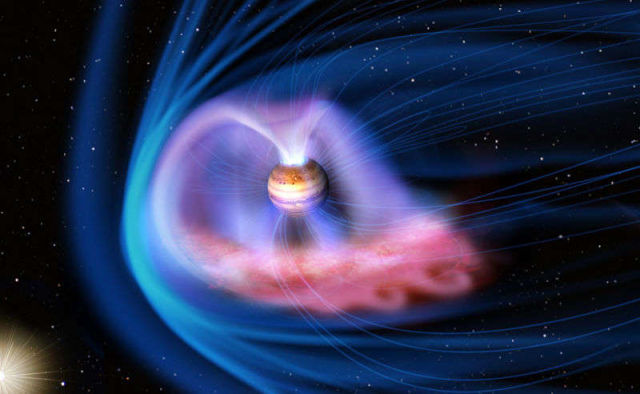Researchers using Chandra data shows how a giant solar storm can ignite auroras on Jupiter.
Storms from the Sun occasionally release extremely large streams of particles via winds that travel through space.
New data show the interaction between the solar wind and Jupiter’s magnetosphere can trigger auroras on the gas giant.
Top image: Jupiter’s x-ray aurora, overlain on a view captured by the Hubble Space Telescope. Image credit Joseph DePasquale, Smithsonian Astrophysical Observatory/Chandra X-ray Center
Above: Artist’s impression of Jupiter’s magnetosphere interacting with the solar wind. Image Credit JAXA
Solar storms are triggering X-ray auroras on Jupiter that are about eight times brighter than normal over a large area of the planet and hundreds of times more energetic than Earth’s ‘northern lights,’ according to a new study using data from NASA’s Chandra X-ray Observatory. This result is the first time that Jupiter’s auroras have been studied in X-ray light when a giant solar storm arrived at the planet.
Lead author and PhD student at UCL Mullard Space Science Laboratory, William Dunn, explains:
“There’s a constant power struggle between the solar wind and Jupiter’s magnetosphere. We want to understand this interaction and what effect it has on the planet. By studying how the aurora changes, we can discover more about the region of space controlled by Jupiter’s magnetic field, and if or how this is influenced by the Sun. Understanding this relationship is important for the countless magnetic objects across the galaxy, including exoplanets, brown dwarfs and neutron stars.”
The Sun constantly ejects streams of particles into space in the solar wind. Sometimes, giant storms, known as coronal mass ejections (CMEs), erupt and the winds become much stronger. These events compress Jupiter’s magnetosphere, the region of space controlled by Jupiter’s magnetic field, shifting its boundary with the solar wind inward by more than a million miles. This new study found that the interaction at the boundary triggers the X-rays in Jupiter’s auroras, which cover an area bigger than the surface of the Earth.
The top composite images show Jupiter and its aurora during and after a CME’s arrival at Jupiter in October 2011. In these images, X-ray data from Chandra (purple) have been overlaid on an optical image from the Hubble Space Telescope. The left-hand panel reveals the X-ray activity when the CME reached Jupiter, and the right-hand side is the view two days later after the CME subsided.
Read more at chandra.harvard.edu






Leave A Comment